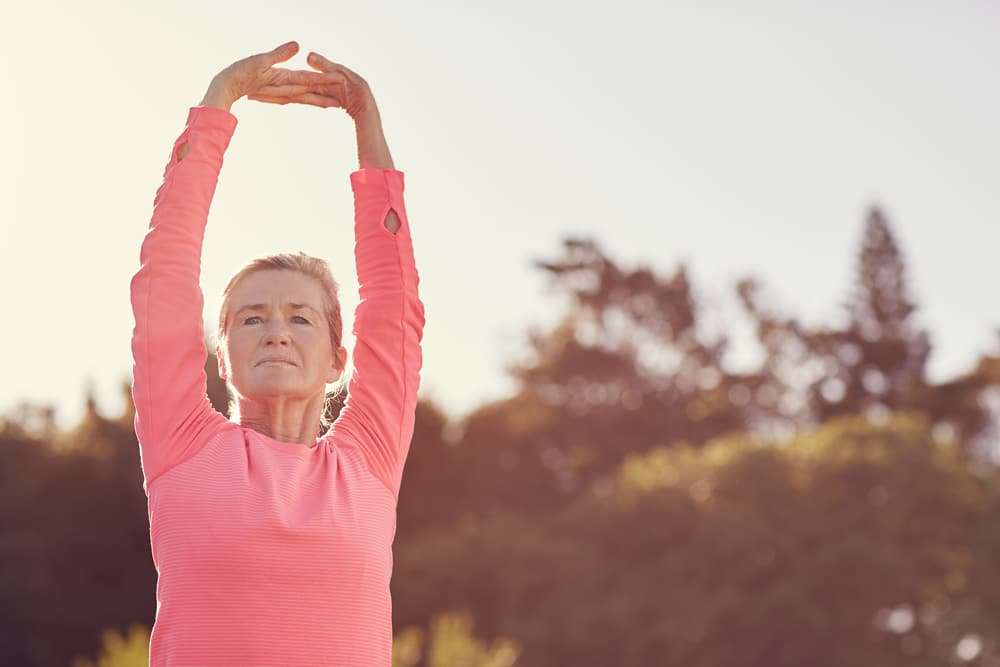What if I told you there is an exercise that improves your mobility, increases your flexibility, and helps you stay independent well into your golden years? It’s as simple as bending over and touching your toes. Stretching for seniors is an easy way to make movement an enjoyable part of your everyday life.
Stretching for Seniors
In repeated studies, it’s been shown that seniors who participate in stretch and flex programs have improved fitness outcomes. They develop more confidence in themselves and their physical abilities, and even improve their overall sense of well-being.
Why is stretching so effective for seniors? As we age, our muscles and joints can weaken, and our range of movement becomes limited as a result. This can make living independently difficult, as tasks such as reaching things on high shelves or picking things up off the floor become painful. Stretching is a gentle and easy way to strengthen your muscles, and it helps you maintain a healthy range of motion. When done regularly, stretching makes you more limber and flexible. It also improves your balance, which can help you avoid dangerous falls and other injuries.
Stretching Tips
If you’re new to stretching regularly, here are a few things to remember as you get started:
- Start where you’re at. Avoid the temptation to launch into complicated yoga poses on your first day. Your muscles and balance will improve if you ease into more difficult movements gradually. Use chairs, walls, and other balance aids as needed.
- Keep breathing. Holding your breath deprives your muscles of oxygen, which means you won’t get the full benefit of the stretch. When you stretch, breathe deeply and regularly, and attempt to deepen your stretch on exhalations.
- Don’t “bounce” in and out of poses. Remember, this is stretching, not aerobics. For your body to get the full benefit, you should work up to holding each stretch for at least 30 seconds. Try for 10 seconds first, then 20. Keep track of your progress.
- If it hurts, don’t do it. Since stretching requires you to hold positions, muscle burn or a little fatigue is common. However, be sure to stop if pain is sudden and sharp, or if you feel it primarily in your joints instead of your muscles. Also, be sure to talk to a doctor before you start any new movement routine.
Beginner’s Stretches
It’s important to get a good idea of your physical abilities before you start stretching on a regular basis. Try these beginner’s stretches and see how you feel:
- Overhead Side Stretch: Stand with your feet hip-width apart, or sit in a chair with your feet firmly planted on the ground and your back straight. Raise your arms overhead, and if you are able, interlace your hands with your palms facing upwards. Lean gently to the left, keeping your ribs lifted and shoulders loose. Hold the pose for ten to 30 seconds, then repeat on the right side.
- Shoulder Stretch: Stand or sit with your back straight. Place your right hand on your left shoulder, or upper-left arm, so your palm is facing your chest. Gently push your arm towards your chest. Hold, then repeat on the other side.
- Hamstring Stretch: Stand or sit with your back straight, with a wall or other chair nearby for balance assistance as needed. Step your left foot forward, and turn your toes upwards so your heel is resting on the floor. Slowly bend forward, keeping your back straight, until you find a comfortable pose. Hold, then repeat on your other leg.
- Calf Stretch: Stand with your right leg directly beneath you, and your left leg in front of you and slightly bent. Gently shift your weight onto your left heel and lean forward. You can use a wall or sturdy chair for balance if needed. Hold, then repeat on your other leg.
If they feel easy, great! You’re ready for a more rigorous routine. If they seem a little difficult, keep trying. With practice and dedication, you’ll soon see positive results.
_____
Doctors recommend that seniors stretch major muscle groups at least two days a week, as well as before any cardiovascular or strength-training exercise. How can you make stretching for seniors a part of your routine?
The Shores of Lake Phalen is an assisted living community in a quiet, peaceful environment in Maplewood, Minnesota. Our apartments’ floor plans are spacious, providing ample room for stretching. We offer numerous health and safety amenities, fun events and activities, a friendly and accommodating staff, and so much more. Schedule a tour of the community to explore our spacious apartments, elegant dining room, and more. We look forward to hearing from you!

